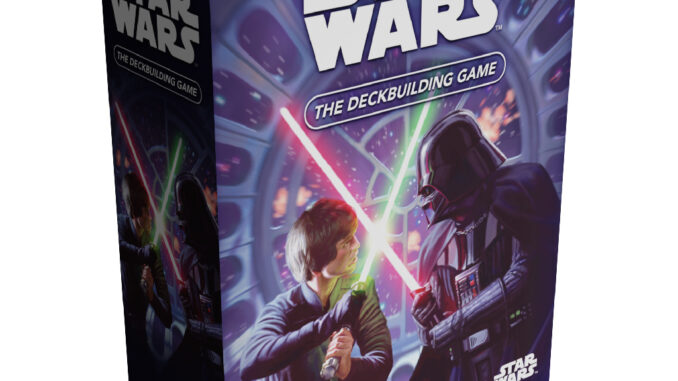
Star Wars? Card game? Those two things have had a rocky history for me. The original LCG that FFG put out, I tried but never got into. I didn’t like the fixed deck aspects all that much. The CCG Destiny game I got really into for awhile but then the blood sucking nature of CCG’s turned me off. I may, or may not, have then printed out all the cards and dice myself for a fraction of the cost.
So when I heard about the latest game, I was hesitant. But, it’s Star Wars, so who are we kidding, of course I picked it up.
Gameplay- A
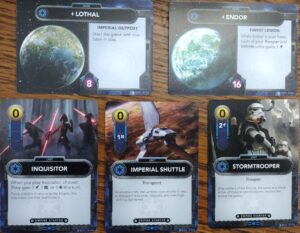
If you’ve played Star Realms before then you will be very familiar with this style of game. The basic structure if you take turns, buying new cards to add to your deck, and attacking your opponent. The first one to defeat the others bases wins. Each player starts out with an identical hand of cards, each just flavored toward either the Empire or Rebellion. In this starting deck, you have many cards that generate one resource when played and a few that generate damage. Each deck also contains a single card that can be used to generate a resource, damage, or Force.
The Force is a unique departure from Star Realms. A board represents the balance of the Force between the players. It starts on the side of the Rebels but the Empire gets to go first. Many cards give you Force points which shift the balance along a track. Other cards gain special benefits if played while the Force is on your side. If the Force is all the way along the track to your side, you gain a free resource at the start of your turn.
Resources are generated by cards and are used to buy new cards from the card pool. The card pool is a group of five face up cards. Each card has a purchase cost you need to buy it. There are three main factions of cards; Rebel, Empire, and Neutral. Unlike Star Realms, which has four color types which each player is free to buy, only Rebel players can buy Rebel cards and vice versa. This leads into another main difference from Star Realms, players are able to “sabotage” opposing faction cards in the card pool.
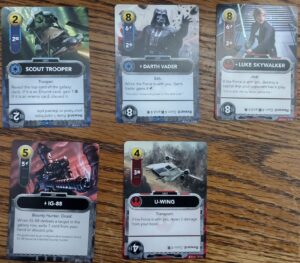
For example, if Darth Vader is in the card pool, the Empire player can purchase him for eight resources. Or the Rebel player can attack him for eight damage and remove him from the card pool. Defeating an opposing faction’s card in the pool not only removes it so they can’t purchase it, but it also gives you an immediate benefit. Each card lists a set of rewards which you gain immediately. In Vader’s case, you get a bunch of resources and four Force points, which could drastically shift the balance all the way back to your side.
The cards themselves are broken into two main types; Capital ships and units. Units are most of the cards. When you play them, they typically give you resources, damage or force. Many also have a secondary effect and the more expensive hero type cards tend to give a combination of resources, damage and force rather than just one of them.
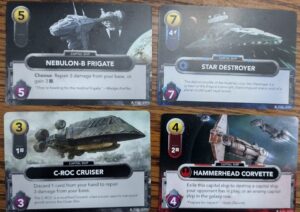
Capital ships work a bit differently. When in the card pool, these cards can not be sabotaged by the opposing player. This means they’ll usually sit in the pool until you can afford to buy them. There are a few ways to remove cards from the pool without sabotaging so they might be removed that way so don’t sit on them too long. When you play a capital ship they work like bases do in Star Realms. They remain in play until defeated and damage done to you has to go to them before it can be placed on your base. In that way, they work like a shield or extra health for your base.
Speaking of your base, this is your health meter. Each player starts with a generic base with only eight health. Once it is destroyed, at the start of their next turn, they select a new base which will have a range of health along with a special ability. Some, like Hoth, have inherent damage reduction which makes them hard to defeat. Others give you a free capital ship from the card pool or do a special affect when you play certain types of cards. Which base you’ll want to pick will depend on the situation in the game. Gaining a Star Destroyer or Mon Calamari cruiser early can be a major benefit, but later in the game, its probably not worth it as those bases tend to have the least health.
Production- B+
The game comes with a strong mix of starting cards, ensuring there is enough variety you don’t see the same cards every game. This is essential to keep the game interesting as some cards are clearly more powerful than others. But you can’t buy those cards if they’re never drawn.
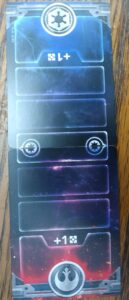
In addition to cards, you also get a Force tracker board and a back of colored cubes. The white cube is for tracking Force, the purple ones for damage and the yellow for resources. You can’t hold onto unused damage/resources after your turn ends so you could play without them if you found another way to track damage. But so far I’ve found them handy to use as you generate them, rather than relying on the cards themselves. If you have cards then generate four resources, you might spend two on a card and then be left with two more to spend later. You might gain some from sabotaging cards in the card pool.
The only real knocks to the game are the box and the cards themselves. The box has slots for storing the different starter decks; the main deck and the generic deck all separate which allows for quick set up for the next game. However, there is a lot of wasted space and there isn’t any room for expansion cards. The cards themselves are not very sturdy. After just a few games ours are already showing signs of fraying and I opted to add card sleeves to protect them.
Theme- A
It’s Star Wars and does a good job of feeling like Star Wars. The Empire’s cards do a good job of enhancing the damage of their generic machines of war while the Rebel elite hero cards can generate some great synergy with each other. Each side has familiar ships and characters you can recruit to your deck.
Expansions- TBD
There are not currently any expansions for this game but that will be an essential component. It works perfectly fine as just the core game but even with a decent starting mix of cards, you’ll need more to ensure each game continues to feel unique.
Conclusion- A
Overall, this is a fun game. It does suffer from the same problem Star Realms has since you are at the whims of the RNG gods in what cards show up in the card pool each game. If a few capital ships appear early, and your opponent grabs them, you can struggle to do enough damage to get through that wall. Or if you start building a deck that likes to sabotage cards in the card pool but then no enemy cards are drawn for awhile, it can shut you down. But that is just the nature of these style games. They are not long games to play so even a bad run won’t drag on.

Wayne Basta
Latest posts by Wayne Basta (see all)
- X-Wing Tier List – Rebels - May 10, 2023

